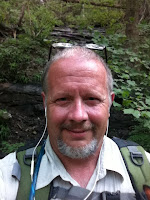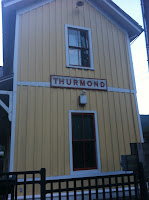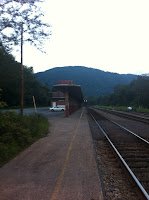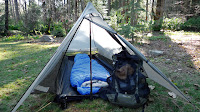Looking At Mileage Rates Of Travel On The AT.
Warning: This is a long post...if you are not interested in statistics, you may want to skip past this post....
So, as I am beginning to try to figure out how many miles are appropriate to travel over the first several weeks of a thru or section hike of the AT. Yes, I know this part of the planning sucks but it is necessary to set your hike up for success. I have read many trail journals and seems that one of the common denominator of persons who finished their section or thru hike was the lower miles they were walking at the beginning of their hike.
This makes sense as no matter how much you try to condition your body for the hike, unless you are in top hiking form, you will be using muscle groups that generally are under utilized in a normal exercise routine. Then there are the concerns of stressing ligaments and tendons especially in the feet, ankles and lower legs. I believe that stress fractures and knee problems will definitely present a higher risk to sidelining the attempt as well. As a long distance hiker, it can take several weeks to get your "trail legs" and get your body in hiking shape while actually hiking the trail.
So, I found this interesting non-scientific study a long time hiker published that gives some interesting insight on mileage data. Although, this study does not take into consideration physical conditioning, in fact it has nothing to do with conditioning we can assume most of these people were in average physical condition at the beginning of their hike. As a hiker, this study tends to agree with my thoughts on daily mileage. I have decided that for this hike, the appropriate approach is to do smaller mileages at the beginning and slowly add miles as my body is conditioned to the trail. This should alleviate some of the physical stress to my body and make the hike more enjoyable and hopefully lessen the risk of having to take time off the trail to rest from overuse of my body.
As I said, this is an interesting study on thru hikers, mileage, and total time spent resting and not actually on the trail from thru hikers that have completed the AT. Statistically this study would not pass a high school statistics class peer review, however, it does have present some interesting trends in how people hiked and how long it took to complete the Appalachian Trail. I found the information valuable and to someone who is planning a section hike, or a thru hike on the Appalachian Trai, will give you food for thought while planning.....to give credit where credit is due, this information was compiled by Steve Shuman, trail name Map Man.
Terms you will see in the Study,
Zero days...days not hiking.
Nero days....days where only a small amount of hiking was attempted.
SOBO.... South Bound Thru hiker who started in Maine.
NOBO...North Bound Thru Hiker who started in Georgia.
Flip-flopper, a hiker who heads one direction, stops somewhere on the tOrail and travels to the other terminus and hikes towards where they got off the trail. This is used by many hikers who have a late start in Georgia to beat the bad weather that may force the closing of Baxter State Park in October allowing them to complete the trail.
AT Hiking Rates, Section by Section
(updated in February 2011)
by map man (Steve Shuman)
I often see anecdotal estimates of how long it takes to hike various sections of the AT, sometimes as miles per day estimates and sometimes as proportions (someone might say, "allow three days to hike in the White Mountains a distance that had taken two on other parts of the trail"), but since the advent of Trailjournals.com we now have access to hundreds of detailed accounts of AT thru-hikes, and since I'm a numbers nerd from way back I decided to see if I could verify with real numbers just how long the typical Thorough Journal Keeper (I'll call them TJKs from now on) takes to hike the AT and various sections within the AT.
So I went through many, many journals day by day for the 2001 thru 2010 hiking seasons and ended up with a group of 240 TJKs who did such a precise job of documenting not only when they started and stopped their thru-hike and when they passed certain relevant landmarks along the way, but even accounted for when and where they took their "zero days."
This study is limited to north bound thru-hikers (NOBOs) who completed their hike in one hiking season and passed ten section defining landmarks along the way in south to north chronological order (though the study does include hikers taking occasional SOBO dayhikes within sections). The sample sizes would not be large enough yet for me to make a meaningful study of SOBOs or flip-floppers, but someday I would like to replicate this study for SOBOs.
The section defining landmarks I chose either have psychological significance (Harpers Ferry is an example of this -- it's often called the psychological half-way point) or mark a change in topography that can influence hiking rates (the Glencliff to Gorham section is an example of this). The points I chose are: Georgia Border, Fontana NC, Damascus VA, Waynesboro VA, Harpers Ferry WV, Delaware Water Gap (DWG) PA, Kent CT, Glencliff NH, Gorham NH and Stratton ME. Combined with Springer and Katahdin they mark off eleven distinct sections.
The study includes 7 NOBOs from the class of 2001, 17 from 2002, 24 from 2003, 33 from 2004, 24 from 2005, 38 from 2006, 30 from 2007, 25 from 2008, 25 from 2009 and 17 from 2010 (these were the only journals from these years detailed enough for this study). This is how the journal keepers broke down by gender: 165 were male, 42 were female, 31 journals were for a male and female hiking together, 1 was for two females hiking together and 1 was for two males hiking together (I count each journal as one hike for this study even if it is for multiple people). When calculating the distances between my landmark points I was aware that these distances sometimes changed slightly from year to year as the trail changes, so with the help of the AT Data Books for various years I calculated a weighted average for the distance of each section based on how many hikers were in the study for a given year.
The result of all this journal reading and number calculating is a DESCRIPTIVE study of a certain thru-hiking population (NOBO thorough journal keepers) and may or may not be representative of all thru-hikers (though I hope it's pretty close). This study is in no way meant to be a PRESCRIPTIVE analysis of how people OUGHT to hike the AT.
So with that said, let's get to the good stuff. Table 1 shows the average (mean) number of days it took these TJKs to hike each section. The first number is the days for that section, the second number is the running total for the hike, and the median number of days to hike each section is listed after the description of that section (The mean number of days for these TJKs to thru-hike was 168.8 while the median number was 171.):
TABLE 1 -- Days to Complete Various Sections
DAYS ~~~ TOTAL DAYS ~~ SECTION
8.0 days..........(8.0)............Springer to Georgia Border (7.7 days)
7.9 days.........(15.9)...........Georgia Border to Fontana (7.7 days)
24.4 days.......(40.3)...........Fontana to Damascus (24 days)
28.7 days.......(69.0)...........Damascus to Waynesboro (28 days)
11.2 days.......(80.2)...........Waynesboro to Harpers Ferry (11 days)
19.2 days.......(99.3)...........Harpers Ferry to DWG (19 days)
12.6 days......(111.9)...........DWG to Kent (12 days)
23.5 days......(135.4)...........Kent to Glencliff (23.2 days)
9.7 days........(145.1)..........Glencliff to Gorham (10 days)
9.9 days........(155.0)..........Gorham to Stratton (9.85 days)
13.7 days...... (168.8)..........Stratton to Katahdin (13.6 days)
When I started this study I was not going to try to figure out how many zero days were being taken but it quickly became apparent that some sections were a lot more prone to hikers taking zero days than others. This would in turn have an effect on how long it took to hike each section and might provide somewhat misleading numbers when calculating miles per day for the average TJK in any given section. Did a section take a longer time to hike solely because of difficulty or were many tempting places to take zero days in the section also playing a role? By figuring out how many zero days were taken in each section both Miles Per Day (MPD) and Miles Per Hiking Day (MPHD) could be calculated. When stripping out the zero days from the calculations, Table 2 shows a remarkably smooth linear progression in the number of miles covered in the first four sections of the trail as TJKs gradually increased the number of miles hiked per day (in the Miles Per Hiking Day calculation). The table also shows that thru-hikers were slowed down by the rugged terrain of the White Mountains and western Maine, though perhaps not quite as much as legend suggests. The first number in this table is MPD (Miles Per Day) and the second number is MPHD (Miles Per Hiking Day). The weighted distances for each section follow the section description:
TABLE 2 -- Miles Per Day and Miles Per Hiking Day
MPD ~~~~~~~ MPHD ~~~~~~ SECTION
9.4 miles..........(10.1 miles).........Springer to Georgia Border (75.6 miles)
11.2 miles........(12.0 miles).........Georgia Border to Fontana (87.5 miles)
12.2 miles........(14.0 miles).........Fontana to Damascus (297.1 miles)
13.4 miles........(15.9 miles).........Damascus to Waynesboro (388.6 miles)
14.4 miles........(16.8 miles).........Waynesboro to Harpers Ferry (161.1 miles)
13.9 miles........(16.8 miles).........Harpers Ferry to DWG (270.3 miles)
13.9 miles........(16.1 miles).........DWG to Kent (172.4 miles)
14.0 miles........(15.5 miles).........Kent to Glencliff (323.8 miles)
10.5 miles........(11.4 miles).........Glencliff to Gorham (100.6 miles)
11.1 miles........(12.5 miles).........Gorham to Stratton (110.1 miles)
13.6 miles........(14.7 miles).........Stratton to Katahdin (187.9 miles)
12.9 miles........(14.7 miles).........The entire AT (2175.0 miles)
Here's the distribution of hikers grouped by the month they left Springer and the month they reached Katahdin:
2 hikers in this study left Springer in January
30 in February
144 in March (60%)
57 in April
7 in May
4 arrived at Katahdin in June
35 in July
52 in August
113 in September (47%)
36 in October
The first date in Table 3 is the median date each point was reached by the TJKs (same number of hikers arriving after this moment as before) and the second date is the mean date:
TABLE 3 -- Date Landmarks Were Reached
MEDIAN DAY ~~ MEAN DAY ~~~ LANDMARK
March 17............March 20...........Springer
March 25............March 28...........Georgia Border
April 1................April 5...............Fontana
April 28..............April 29..............Damascus
May 29..............May 28..............Waynesboro
June 9...............June 8...............Harpers Ferry
June 29.............June 27..............DWG
July 12..............July 10...............Kent
Aug. 5...............Aug. 2...............Glencliff
Aug. 15.............Aug. 12..............Gorham
Aug. 26.............Aug. 22..............Stratton
Sept. 9..............Sept. 4..............Katahdin!
Of course no single hiker is "typical" and people will vary in their own ways from the 168.8 days (about five and a half months) it took these TJKs to get to Katahdin. But I think it can be useful to see the rate of progress these TJK thru-hikers have experienced on their way there for planning purposes. One thing I discovered is that if a group of hikers in this study taking four months to thru-hike takes 20% less time to get there than a group taking five months, 33% less time than six month hikers and 43% less time than seven month hikers, those figures tend to stay true for each section within the thru-hike as well. So with that in mind I calculated the number of days a "typical" TJK thru-hiker might have needed to reach these section landmarks for four different hypothetical hikes. Table 4 lists the "typical" number of days it would take to reach each landmark for hikers taking 4 months (122 days), 5 months (153 days), 6 months (183 days) and 7 months (214 days) to thru-hike:
TABLE 4 -- Four Hypothetical Hikes
4#HIKE ~~~ 5#HIKE ~~~ 6#HIKE ~~~ 7#HIKE ~~~ LANDMARK
6 days...........7 days..........9 days..........10 days..........Georgia Border
11 days.........14 days........17 days.........20 days..........Fontana
29 days.........37 days........44 days.........51 days..........Damascus
50 days.........63 days........75 days.........87 days..........Waynesboro
58 days.........73 days........87 days.........102 days.........Harpers Ferry
72 days.........90 days........108 days.......126 days.........DWG
81 days.........101 days......121 days.......142 days.........Kent
98 days.........123 days......147 days.......172 days.........Glencliff
105 days.......132 days......157 days.......184 days.........Gorham
112 days.......141 days......168 days.......197 days.........Stratton
122 days.......153 days......183 days.......214 days.........Katahdin
Finally, I wanted to take a close look at the nature of "zero days," the days that no miles are logged by hikers on the AT (TJKs took a mean 20.7 of them on their thru-hikes -- the median number of zero days was 19). I wanted to look at both the short term breaks (1 or 2 day breaks from the trail) and long term breaks (3 or more consecutive days with no AT miles hiked). I hypothesized that hikers would need to take a lot of the short term breaks in their earlier days on the trail to cope with hiker's fatigue and with the sometimes nasty weather in the southern Appalachians in March and April, and that these short term breaks would lessen in frequency as a hiker walked north. It appears I was wrong, as Table 5 shows. TJKs took very few of these zero days in the first two sections. It's my speculation now that hikers seemed to take these short term breaks largely due to the availability of trail towns and concentration of hiker focused shuttle services and hostels. For example, the section with the highest percentage of these short term zero days taken was the Fontana to Damascus section with Hot Springs, Erwin and many famously hospitable hiker services in this stretch.
On the other hand, I hypothesized that long term breaks (breaks of 3 or more consecutive days when hikers often leave the vicinity of the trail completely) would be scarce in the early days when the novelty and newness of the experience alone might carry people forward and again scarce toward the end when the goal was so close, and more frequent in the middle of the journey. On this, it sure looks like I was right, as the "Long Term Break" percentages in each hiking section in Table 5 show. In this table the first number is percentage of days taken to complete a section that are zero days. The second and third numbers break the zero days into two groups -- STBs (zero days taken in Short Term Breaks of 1 or 2 days) and LTBs (days taken in Long Term Breaks of 3 straight days or more):
TABLE 5 -- Zero Days
%ZERO DAYS ~ %STB ~~~ %LTB ~~~ SECTION
....(5.7%)..........(4.8%)........(0.9%)........Sp ringer to Georgia Border
....(7.5%)..........(6.3%)........(1.2%)........Ge orgia Border to Fontana
....(13.0%)........(9.0%)........(4.0%).........Fo ntana to Damascus
....(15.0%)........(8.2%)........(6.7%).........Da mascus to Waynesboro
....(14.3%)........(7.8%)........(6.4%).........Wa ynesboro to Harpers Ferry
....(16.3%)........(7.3%)........(9.0%).........Ha rpers Ferry to DWG
....(14.9%)........(7.6%)........(7.3%).........DW G to Kent
....(11.1%)........(7.2%)........(3.8%).........Ke nt to Glencliff
....(9.1%)..........(6.8%)........(2.3%).........G lencliff to Gorham
....(11.1%)........(8.5%)........(2.6%).........Go rham to Stratton
....(7.3%)..........(5.8%)........(1.6%)........St ratton to Katahdin
....(12.3%)........(7.5%)........(4.8%).........Fo r entire AT
METHODOLOGY
If a hiker started on the approach trail to Springer and only went as far as the Springer Mountain Shelter I didn't count that as the first day of the thru-hike even though .2 miles of the AT were covered. Likewise, if a person got a ride to USFS 42 and walked the .9 miles to Springer and hiked no more of the AT that day I didn't count that as the first day of the hike either. I think these small partial days would distort the results for the first short section to the Georgia border. The day a hiker passes USFS 42 going north is the day I start the thru-hike clock ticking for the purposes of this study.
When a hiker reached one of my landmark points -- for example, Waynesboro -- I stop the clock for that section (in this case, the Damascus to Waynesboro section) and start the clock for the next section. So any zero days that hiker took in Waynesboro are counted in the Waynesboro to Harpers Ferry section.
If a hiker passed a landmark, let's say DWG, and hiked on past without stopping for the day, I break that day into fractions of tenths of a day. So if that day began at Kirkbridge Shelter, 6.4 miles short of DWG, and ended at the "Backpacker Site" 4.8 miles past DWG, I counted six tenths of that day in the Harpers Ferry to DWG section and four tenths of that day in the DWG to Kent section.
In tracing hikers' progress in their journals I used all the clues available to tally zero days and hiking progress. Some were very thorough and gave exact starting and ending points for each day, with mileage accurately logged and separate entries for each zero day as well. These journals were easy to follow. But not all journals used in the study were this thorough. Some just gave starting and stopping points. Some only registered mileage. Some were odd combinations of the two. Some left gaps when they took zero days. Some would recount multiple days of hikes in one entry (and all of these oddities often meant that the "Stats" section available to look at for each journal at Trailjournals.com had inaccurate numbers for "zero days" and "hiking days"). As long as I could reconstruct what had happened, even if it took reading the entire text of multiple journal entries to get it done, I made every effort to do it. But if there was anything in the journal that made me uncertain if every stretch of trail was actually hiked, and about tracking which days were hiked, and which devoted to zero days, I did not include that journal in this study.
(For a more in-depth discussion of how data was gathered for this article, and a series of tables and illustrations going into more detail about different aspects of the data, as well as my responses to suggestions from White Blaze members with more knowledge of statistical methods than I have, see Post #28 in this thread. For information on which towns TJKs were most likely to take zero days, see Post #69. For preliminary findings on how the numbers for men and women compare, see Post #80. For a table comparing miles hiked per day with trail ruggedness, see Post #93.)
ACKNOWLEDGEMENTS
A big thank you to the folks who created and maintain Trailjournals.com and WhiteBlaze.net. These sites are a great service to the hiking community. I could not have done this study without Trailjournals and could not hope to share it with so many people without WhiteBlaze. And thank you as well to all the WhiteBlaze members who offered suggestions to improve this article or offered encouragement.
Some of his other extrapolated data appears below.
Estimated time to certain milage points on a thru hike:
Mile 0 to 100 -- 10.2 days (10.2)
100 to 200 -- 8.6 days (18.8)
200 to 300 -- 8.2 days (27.0)
300 to 400 -- 8.2 days (35.2)
400 to 500 -- 7.9 days (43.1)
500 to 600 -- 7.5 days (50.6)
600 to 700 -- 7.4 days (58.0)
700 to 800 -- 7.5 days (65.5)
800 to 900 -- 7.1 days (72.6)
900 to 1000 -- 7.0 days (79.6)
1000 to 1100 -- 7.1 days (86.7)
1100 to 1200 -- 7.2 days (93.9)
1200 to 1300 -- 7.3 days (101.2)
1300 to 1400 -- 7.2 days (108.4)
1400 to 1500 -- 7.1 days (115.5)
1500 to 1600 -- 7.2 days (122.7)
1600 to 1700 -- 7.1 days (129.8)
1700 to 1800 -- 7.7 days (137.5)
1800 to 1900 -- 9.5 days (147.0)
1900 to 2000 -- 8.7 days (155.7)
2000 to 2100 -- 7.3 days (163.0)
2100 to end -- 5.4 days (168.4)
And one on daily miles and elevation gain.
A little over a year ago iamscottym asked about elevation gain and loss on the AT, wondering how it correlated to the hiking speeds that I reported in this article. Well, I have now calculated the elevation change for many sections large and small on the AT and published it in "AT Elevation Gain and Loss, by Section," in the articles forum (and hopefully it will be moved to the articles section on the front page in the coming weeks). So here is a table showing average elevation gain and loss per mile for each of the eleven sections in this article. In this table MPHD is Miles Per Hiking Day, EGPM is Elevation Gain Per Mile (expressed as feet per mile), and EGPD is Elevation Gain Per Day (expressed as feet per day). So in the two elevation categories the number "3100" would mean a hiker had gone 3100 feet up and also 3100 feet down. (The numbers in this table are based on the 2001-2007 hiker classes. I did not recalculate them after adding the 2008-2010 classes to the hiking rates study. The differences would be very minor.)
EGPD~~EGPM~~MPHD~~~SECTION
3100.......307.......10.1........Springer - Georgia border
3310.......276.......12.0........Georgia border - Fontana
3780.......270.......14.0........Fontana - Damascus
3970.......248.......16.0........Damascus - Waynesboro
3610.......215.......16.8........Waynesboro - Harpers Ferry
2350.......139.......16.9........Harpers Ferry - DWG
3160.......196.......16.1........DWG - Kent
3600.......231.......15.6........Kent - Glencliff
4090.......353.......11.6........Glencliff - Gorham
4250.......335.......12.7........Gorham - Stratton
2890.......198.......14.6........Stratton - Katahdin
3470.......236.......14.7........Entire Trail
People can decide for themselves how much the changing distances hiked each day is due to increasing fitness (or increased breaking down of knees and other body parts in latter stages

) and how much to changing ruggedness of the trail.
And Where hiker zero days were taken..
Neels Gap GA (US 19, 129), 8%
Helen, Unicoi Gap GA (GA 75), 7%
Hiawasee GA (US 76), 22%
Franklin NC (US 64), 26%
Nantahala Outdoor Center NC (US 19, 74), 18%
Fontana NC (NC 18), 38%
Gatlinburg TN (US 441), 22%
Standing Bear Farm NC (NC 284, I 40, Waterville School Road), 8%
Hot Springs NC (US 25, 70), 61%
Erwin TN, 40%
Elk Park NC, Roan Mountain TN (US 19E), 6%
Kincora Hostel, Laurel Fork Lodge TN (Dennis Cove Road), 13%
Damascus VA, 84%
Troutdale VA (VA 16), 6%
Atkins VA (US 11), 9%
Bland VA (US 21/52), 7%
Pearisburg VA (US 460), 51%
Catawba VA (VA 311, 624), 10%
Daleville, Roanoke, etc. VA (US 11, 220), 38%
Waynesboro VA (US 250, I 64), 50%
Front Royal VA (US 522), 16%
Harpers Ferry WV, 50%
Pine Grove Furnace State Park PA, 5%
Boiling Springs PA (PA 174), 7%
Duncannon PA, 27%
Port Clinton PA, 15%
Palmerton PA (PA 873), 10%
Delaware Water Gap PA, 35%
Unionville NY, 5%
Vernon NJ (NJ 94), 7%
Bear Mountain NY, 10%
Pawling NY (County 20), 5%
Kent CT (CT 341), 14%
Salisbury CT (CT 41), 6%
Great Barrington MA (MA 23), 6%
Upper Goose Pond Cabin MA, 5%
Dalton MA, 20%
North Adams MA (MA 2), 7%
Bennington VT (VT 9), 6%
Manchester Center VT (VT 11, 30), 23%
Killington, Rutland, Inn at Long Trail VT (US 4), 19%
Hanover NH, 28%
Glencliff NH (NH 25), 13%
Kinsman Notch NH, 5%
Franconia Notch NH, 15%
Crawford Notch NH, 13%
Pinkham Notch NH, 10%
Gorham NH (US 2), 44%
Andover ME (East B Hill Road, South Arm Road), 15%
Rangeley ME (ME 4), 14%
Stratton ME (ME 27), 15%
Caratunk ME (US 201), 7%
Monson ME, 32%
Baxter State Park and vicinity ME (Abol Bridge, Millinocket etc.), 14%.
End.
So, there you go, some interesting information huh? Thanks to Map Man and all the work he put into this analysis. This study was posted on the Internet at
www.whiteblaze.com in one of the forums and there was quite a bit of discussion regarding the study both pro and con. It makes for interesting reading. Just so a quick google search and I am sure you can find it.
Now go out and hike your own hike.
AT Hiker.
























 ) and how much to changing ruggedness of the trail.
) and how much to changing ruggedness of the trail.